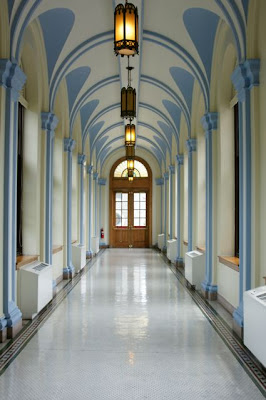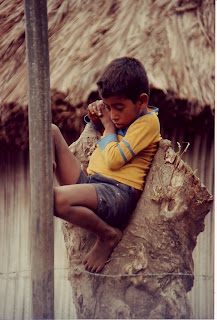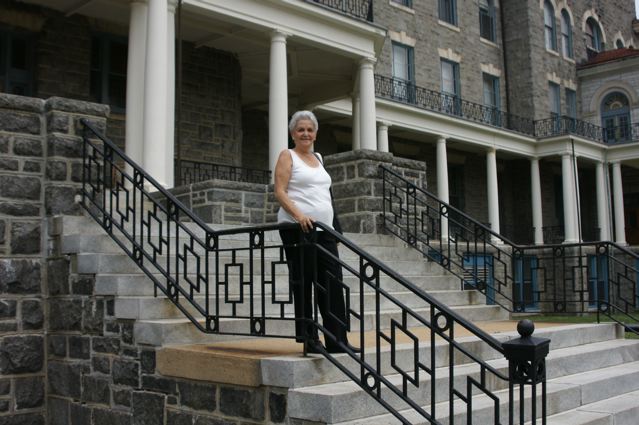My Salvadoran mother-in-law (the star, in part, of my memoir,
Still Love in Strange Places) has been in town, nursing a leg that has borne the brunt of a brave life—an early operation, a terrible accident at Nora's coffee farm, repeated torques and falls. Just two weeks ago, yet another cast was removed, leaving Nora commandeering a borrowed cane. So that she is here, and we look for things to do that will not tax her further.
Yesterday we drove Nora to
Immaculata University, where, in 1952, she spent a year studying with her Salvadoran girlfriends. A dear nun let us in through a back door, showed us the elevator, and we were in—walking the halls that Nora once walked as an eighteen-year-old girl in a brand-new (and only briefly borrowed) country. Horses brought the students the mail, we learned. The girls smoked across the street. A taxi ("very cheap, you know") would take them down country roads, to West Chester, where they would buy the "more delicious" food.
This afternoon, we've been sitting together watching
WASTE LAND, the Academy Award Nominee for Best Feature Documentary, which can be instant-queued from Netflix. I could hardly do a better job of succinctly describing the essence of this deeply moving, so ultimately humane film than the film's own web site, so I paste that description in here.
Filmed over nearly three years, WASTE LAND follows renowned artist Vik Muniz as he journeys from his home base in Brooklyn to his native Brazil and the world's largest garbage dump, Jardim Gramacho, located on the outskirts of Rio de Janeiro. There he photographs an eclectic band of “catadores”—self-designated pickers of recyclable materials. Muniz’s initial objective was to “paint” the catadores with garbage. However, his collaboration with these inspiring characters as they recreate photographic images of themselves out of garbage reveals both the dignity and despair of the catadores as they begin to re-imagine their lives. Director Lucy Walker (DEVIL’S PLAYGROUND, BLINDSIGHT and COUNTDOWN TO ZERO) and co-directors João Jardim and Karen Harley have great access to the entire process and, in the end, offer stirring evidence of the transformative power of art and the alchemy of the human spirit.

Watch this movie straight through its closing credits, and you'll sit in silence afterward—reminded of the power of yearning over having, of making over done, of open hearts versus decided ones. Sit with those you have come to love, and reflect on what finally matters.
We bring out the old albums, and, remembering, they talk. The long gone near again, curiosity alive. I could almost imagine (listening to them remember) that the stories themselves had not yet unfolded, had not revealed their denouement. When I wrote
Still Love in Strange Places years ago, I was writing about my Salvadoran husband's family stories, about the capacity for reimagining, and about the pliable nature of marriage. I was writing to get it right. But listening again to his family tell his family stories this weekend, I remembered what perhaps I've always known: You never get it all just right. Stories mutate with time, and with the teller.
 Though there was a war on and I'd been cautioned, I was often alone in El Salvador. I never believe, as much as I should, in danger. On this day we'd left in a mad hurry from the white house in Santa Tecla and driven a highly militarized road (guns everywhere, soldiers at attention) to the raw edge of a cattle-and-pigs somewhere, where we loaded our hastily assembled things into a pontoon of sorts and floated to an estuary. No one told me, until much later, that we were escaping the threat of bombs, a report that the American Embassy had been targeted.
Though there was a war on and I'd been cautioned, I was often alone in El Salvador. I never believe, as much as I should, in danger. On this day we'd left in a mad hurry from the white house in Santa Tecla and driven a highly militarized road (guns everywhere, soldiers at attention) to the raw edge of a cattle-and-pigs somewhere, where we loaded our hastily assembled things into a pontoon of sorts and floated to an estuary. No one told me, until much later, that we were escaping the threat of bombs, a report that the American Embassy had been targeted.
The others unpacked and spoke in their Spanish. I was confused and wandered away. Down a dirt road where women balanced jugs of water on their heads and the houses were brilliantly thatched.
Finally I stopped and waited for this boy to look up and see me. Beyond the thin barbed wire, he would not. I wonder to this day what he was thinking.
 We taught each other, Ana Gabriella,
We taught each other, Ana Gabriella,
In the kitchen, in the courtyard,
Wherever Nora’s maids weren’t looking.
This was after the war and before the earthquake,
When the country smelled like coffee
And optimism was a saunter on the street,
Though there were men with rifles everywhere and cautions:
Go nowhere alone, go nowhere bearing jewelry.
Sometimes I held your hand or you took mine,
And my Spanish was incurable so we talked
By walking, by noticing the same bird in the sky,
By sinking our fingers into the bullet holes that
Splattered stucco homes, turquoise and salmon
And porcelain-colored homes. You were nine,
And had I daughter I’d have chosen you, and this was
Before you stole me roses from Nora’s garden,
Cut them with stolen scissors when they were whole
And redly bloomed. You have grown up in the meantime,
I have heard, and five years of growing at your age
Is a long time, so that last week, when your card arrived
And I saw your handwriting for the first time,
I was both humbled and surprised. Remembering
El Salvador is also always remembering you,
Ana Gabriella, and the roses I longed to carry home.








Your mother-in-law sounds like a fascinating person. I am left wanting to learn more about this coffee farm? I hope her leg heals soon and you all have a great visit together.
I have to see this film.